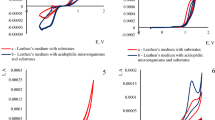Abstract
In recent years, the bioleaching of sulfidic raw materials has been of great interest. However, the application of this biotechnology is now very limited for many different complex reasons. The mechanism of the chemical and electrochemical reactions taking part in the process is not well understood. The application of electrochemical techniques is useful in its elucidation. Among the common sulfides, galena has been studied very little with respect to its behavior during bioleaching. Therefore, the electrochemical evolution of massive electrodes of lead sulfide in the presence and absence of a mixed culture of mesophilic microorganisms was investigated by the application of potentiometry, anodic and ca-thodic polarization and cyclic voltammetry. The agitation rate, the use ofpH control and the composition of the nutrient mediums did not have any significant affects on the oxidation of galena. However, the temperature (25° to 45 °C), the scan rate (4 to 100 mV/s) and the acid used to adjust the pH were significant variables that influenced sulfide oxidation. Therefore, the peak (600 to 1,000 mV) corresponding to the oxidation of sulfide ions from the mineral was only detected in the presence of a complexing anion of lead. In the presence of bacteria, the peaks corresponding to galena oxidation decreased and, at the same time, new peaks appeared both during the oxidation at −300 mV and during the reduction of the mineral surface at 150 and −300 mV. These signals were more important when the attack time increased. The rest potential ofbioleached mineral increased with an increase in leaching time, which was related to the electrochemical transformation of the galena surface.
Similar content being viewed by others
References
Bosecker, K., 1984, “Biodegradation of sulfur minerals and its applications for metal recovery,” Studies in Inorganic Chemistry, Vol. 5, pp. 331–348.
Brierley et al., 1978, “Bacterial Leaching,” CRC Cht. Rev. Microbiol., Vol. 6, pp. 207–262.
Fuerstenau, M.C., Chen, C.C., Han, K.N., and Palmer, B.R., 1986, “Kinetics of galena dissolution in ferric chloride solutions,” Met. Trans. B., Vol. 17B, pp. 415–423.
Fuerstenau, M.C., Nebo, C.O., Elango, B.V., and Han, K.N., 1987, “The kinetics of leaching of galena with ferric nitrate,” Met. Trans. B., Vol. 18B, pp. 25–30.
Habashi, F., 1983, “Dissolution of minerals and hydrometallurgical processes,” Naturwissenschaften, Vol. 70, pp. 403–411.
Lizama, H.M., and Suzuki, I., 1989, “Bacterial leaching of a sulfide ore by Thiobacillus ferrooxidans,” Hydrometallurgy, Vol. 22, pp. 301–310.
Norris, P.R., and Kelly, D.P., 1983, “Iron and mineral oxidation with Leptospirillum-like bacteria,” Recent Progress in Biohydrometallurgy, G. Rossi and A.E. Torma, ed., Asoc. Minera, Sarda, Iglesias.
Rossi, G., 1990, Biohydrometallurgy, McGraw-Hill, New York.
Sand, W., Rohde, K., Sabotke, B., and Zenneck, C., 1992, “Evaluation of Leptospirillum ferrooxidans for leaching,” Applied and Environmental Microbiology, Vol. June pp. 85–92.
Scott, P.D., and Nicol, M.J., 1976, “Kinetics of non-oxidative dissolution of galena in acidic chloride solutions,” Transactions IMM, London, Vol. 85, pp. C40–44.
Tomizuka, N., and Yagisawa, M., 1978, “Optimum conditions for leaching of uranium and oxidation of lead sulfide with Thiobacillus ferrooxidans and recovery of metals from bacterial leaching solutions with sulfate reducing bacteria,” Metallurgical Applications of Bacteria Leaching and Related Microbial Phenomena, L.E. Murr, A.E. Torma and J.A. Brierley, eds., Academic Press, New York, pp. 321–344.
Torma, A.E., and Subramanian, K.N., 1974, “Selective bacterial leaching of a lead sulfide concentrate,” Int. J. Miner. Process., Vol. 1, pp. 125–134.
Author information
Authors and Affiliations
Additional information
Nonmeeting paper number 99–307. Discussion of this peer-reviewed paper is invited and must be submitted to SME prior to Nov. 30, 2000.
Rights and permissions
About this article
Cite this article
González-Chávez, J.L., González, F., Ballester, A. et al. Effect of mesophilic microorganisms on the electrochemical behavior of galena. Mining, Metallurgy & Exploration 17, 116–120 (2000). https://doi.org/10.1007/BF03402838
Received:
Accepted:
Published:
Issue Date:
DOI: https://doi.org/10.1007/BF03402838




